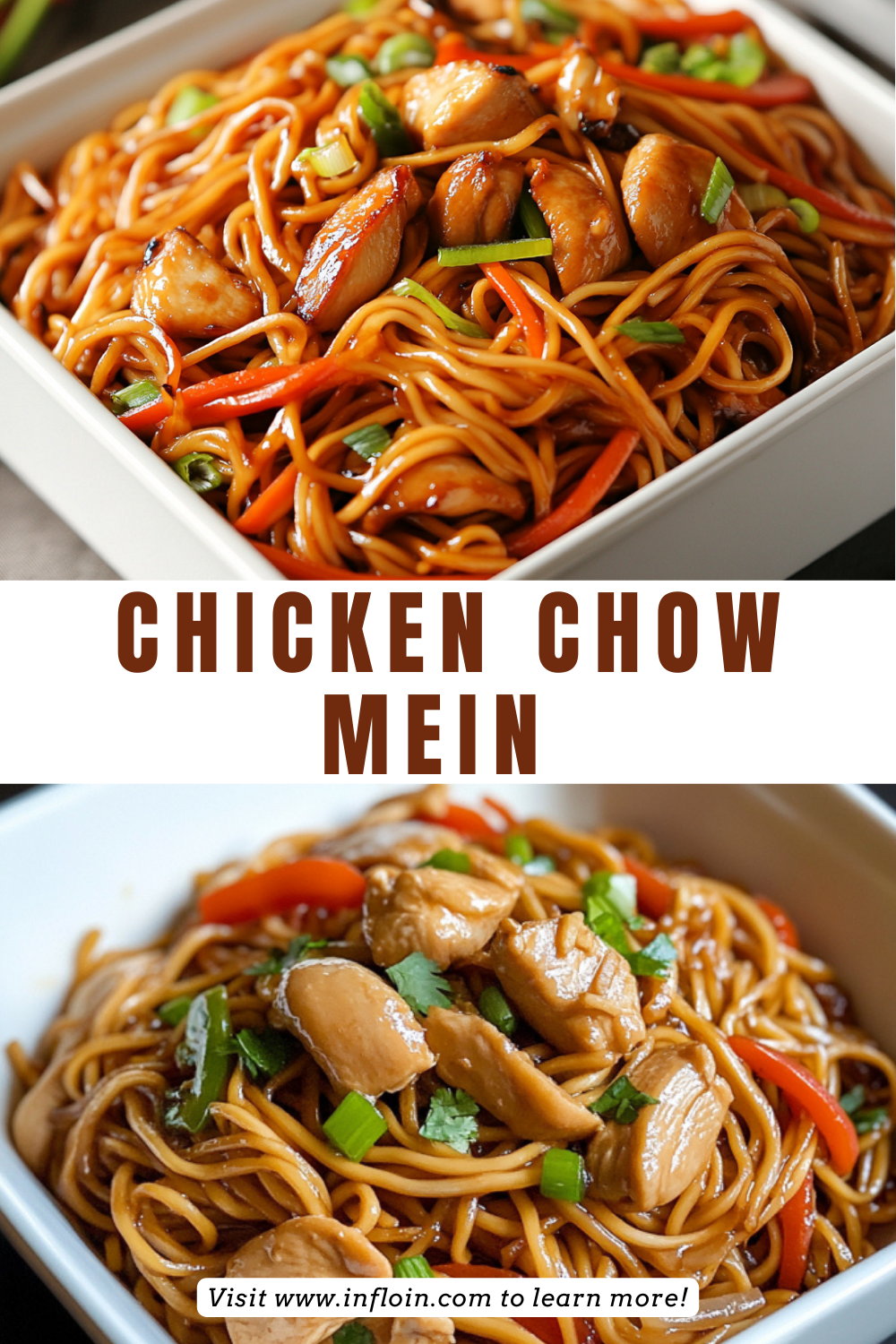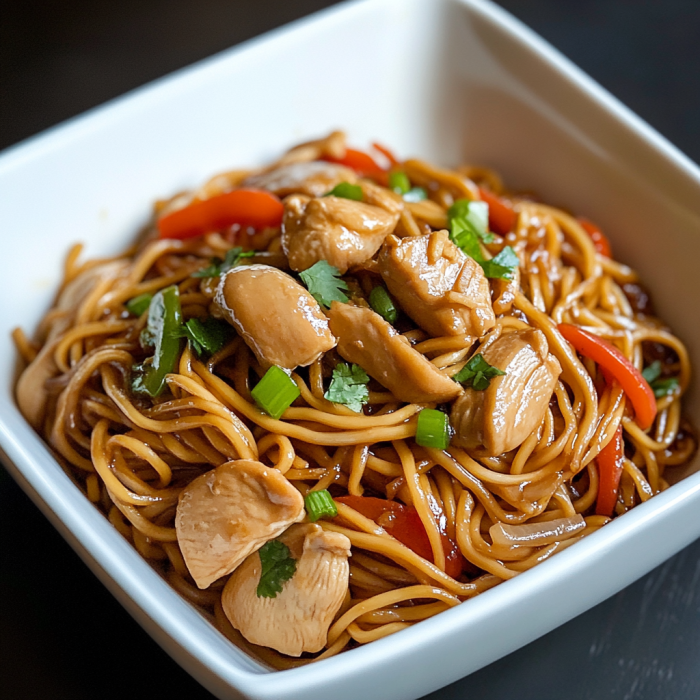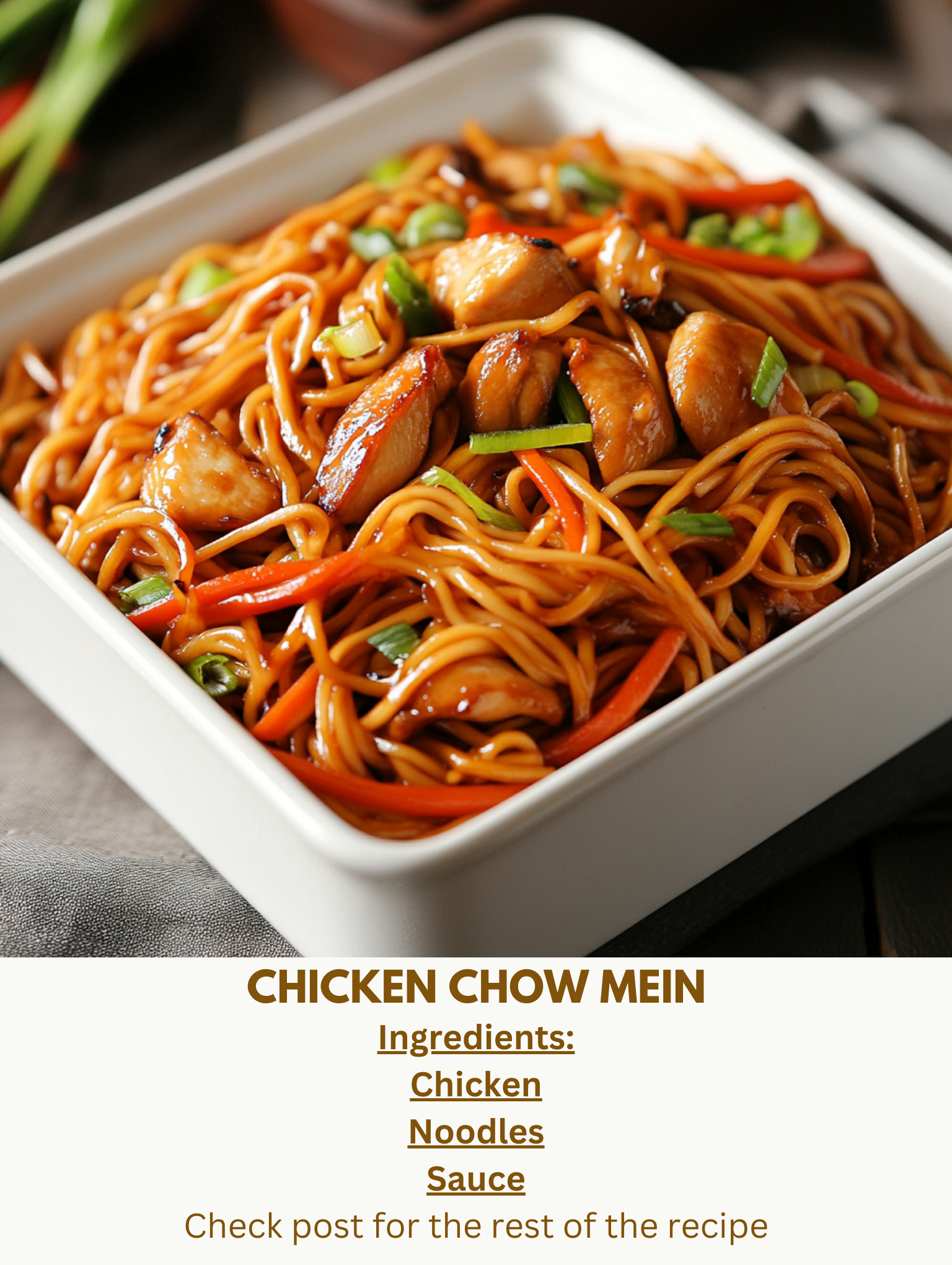Chicken Chow Mein is a beloved Chinese-American dish that combines tender chicken, crisp vegetables, and savory noodles in a delicious stir-fry. This recipe offers a healthier and budget-friendly alternative to takeaway, without sacrificing taste. It can be prepared in under 30 minutes, making it an ideal weeknight dinner.
What Is Chicken Chow Mein?
Chicken Chow Mein is a classic stir-fried noodle dish that originated in China and has become a staple in Chinese-American cuisine. The term “Chow Mein” translates to “stir-fried noodles,” and the dish typically features thin egg noodles, tender pieces of chicken, and a variety of vegetables, all tossed together in a savory sauce. The key to a great Chicken Chow Mein lies in achieving the perfect balance of flavors and textures.
Ingredients for Chicken Chow Mein
To prepare Chicken Chow Mein, you’ll need the following ingredients:
-
Chicken Breast: Boneless and skinless chicken breasts, thinly sliced into strips.
-
Chow Mein Noodles: Fresh or dried egg noodles, boiled until al dente.
-
Vegetables: A mix of bell peppers, carrots, cabbage, and bean sprouts.
-
Aromatics: Garlic and ginger, finely minced.
-
Sauce: A combination of soy sauce, oyster sauce, sesame oil, and a touch of sugar.
-
Cornstarch: To marinate the chicken and thicken the sauce.
-
Oil: For stir-frying, such as vegetable or peanut oil.
Cooking Time, Preparation Time, and Servings
-
Preparation Time: 15 minutes
-
Cooking Time: 10 minutes
-
Total Time: 25 minutes
-
Servings: 4 servings
Why You’ll Love This Recipe
-
Quick and Easy: Ready in just 25 minutes, perfect for busy weeknights.
-
Healthy Ingredients: Packed with lean protein and fresh vegetables.
-
Customizable: Easily adjust the vegetables and protein to your preference.
-
Budget-Friendly: A cost-effective alternative to takeout.
-
Delicious Flavor: A perfect balance of savory, sweet, and umami flavors.
Ingredient Notes
-
Chicken: For a leaner option, you can substitute chicken breast with chicken thighs.
-
Noodles: If you can’t find chow mein noodles, you can use spaghetti or rice noodles as alternatives.
-
Sauce: Adjust the amount of soy sauce and oyster sauce to suit your taste preferences.
-
Vegetables: Feel free to add or substitute vegetables like mushrooms, broccoli, or snow peas.
How to Make Chicken Chow Mein
Step 1: Marinate the Chicken
In a bowl, combine the sliced chicken with a tablespoon of soy sauce, a teaspoon of cornstarch, and a pinch of white pepper. Mix well and let it marinate for about 10 minutes.
Step 2: Prepare the Noodles
Boil the chow mein noodles according to the package instructions until al dente. Drain and rinse under cold water to stop the cooking process. Drizzle with a little sesame oil to prevent sticking.
Step 3: Stir-Fry the Chicken
Heat a wok or large skillet over medium-high heat and add a tablespoon of oil. Add the marinated chicken and stir-fry until it’s cooked through and lightly browned. Remove the chicken from the wok and set it aside.
Step 4: Cook the Vegetables
In the same wok, add another tablespoon of oil. Add the minced garlic and ginger, and sauté for about 30 seconds until fragrant. Add the sliced bell peppers, carrots, and cabbage. Stir-fry for 2-3 minutes until the vegetables are tender-crisp.
Step 5: Combine and Serve
Return the cooked chicken to the wok along with the cooked noodles. Pour the prepared sauce over the mixture and toss everything together until well combined and heated through. Serve hot, garnished with green onions and sesame seeds if desired.
Storage Options
Leftover Chicken Chow Mein can be stored in an airtight container in the refrigerator for up to 3 days. To reheat, simply warm it in a skillet over medium heat, adding a splash of water or soy sauce to prevent it from drying out.
Variations and Substitutions
-
Vegetarian Version: Replace the chicken with tofu or tempeh for a plant-based alternative.
-
Gluten-Free Option: Use gluten-free soy sauce and rice noodles instead of regular noodles.
-
Spicy Kick: Add sliced chili peppers or a dash of chili oil to the stir-fry for some heat.
Pairings and Accompaniments
Chicken Chow Mein pairs wonderfully with a variety of side dishes:
-
Asian Cabbage Salad: A refreshing salad with a tangy dressing.
-
Spring Rolls: Crispy rolls filled with vegetables or shrimp.
-
Hot and Sour Soup: A flavorful soup to start your meal.
Comparison with Similar Recipes
Compared to Lo Mein, which uses soft, uncrispy noodles, Chicken Chow Mein features stir-fried noodles that offer a delightful crunch. Both dishes are versatile and can be customized with different proteins and vegetables to suit your taste.

Frequently Asked Questions (FAQs)
What is special about chow mein?
Chow Mein stands out due to its crispy, stir-fried noodles and rich savory flavor. The technique of stir-frying at high heat gives the dish its signature texture—lightly crispy noodles combined with tender meat and vegetables. It’s also incredibly versatile, which allows cooks to personalize it easily with a wide range of ingredients.
Additionally, it’s a crowd-pleaser. Whether you prepare it with chicken, tofu, or only vegetables, its vibrant taste and visual appeal make it a go-to for family dinners or meal prep.
What does chicken chow mein contain?
Chicken Chow Mein typically contains:
-
Sliced chicken breast
-
Chow mein noodles or egg noodles
-
Fresh vegetables such as bell peppers, carrots, and cabbage
-
Garlic and ginger for aromatics
-
A flavorful sauce made of soy sauce, oyster sauce, and sesame oil
Altogether, these ingredients are quickly stir-fried to preserve their taste and texture.
What culture is chicken chow mein?
While Chicken Chow Mein originates from Chinese cuisine, it has been widely adapted in the United States and other Western countries. In American-Chinese food culture, it’s become one of the most recognized and frequently ordered dishes.
The recipe showcases the adaptability of Chinese cooking, merging traditional stir-fry methods with local tastes. It reflects a culinary bridge between East and West.
What to marinate chicken in for chow mein?
For tender and flavorful chicken, marinate it with:
-
Soy sauce
-
Cornstarch
-
A touch of sesame oil
-
Freshly ground white pepper
Let the chicken sit in this mixture for at least 10 minutes. This enhances its flavor and ensures it stays moist during stir-frying. Some cooks also add a bit of ginger or garlic to the marinade for more depth.
Best Time to Enjoy the Recipe
Chicken Chow Mein is ideal for:
-
Lunch: Quick, energizing, and easy to carry to work or school.
-
Dinner: Light yet satisfying, and ready in under 30 minutes.
-
Leftover meal: Reheats well, making it excellent for next-day lunches.
-
Weekend gatherings: A great dish to serve in large batches for guests.
Although not common for breakfast, it can be enjoyed any time of the day depending on your preference. Its flexibility makes it suitable for any meal where comfort food is desired.
Presentation Tips
To elevate your Chicken Chow Mein visually:
-
Use a wide, shallow plate: This helps spread the noodles and toppings for a colorful presentation.
-
Garnish with sliced green onions: Adds freshness and color contrast.
-
Sprinkle with sesame seeds: For texture and a polished look.
-
Serve with chopsticks and a side of dipping sauce: Adds authenticity and enhances the dining experience.
For a festive touch, consider serving in takeout-style boxes for a fun, restaurant-inspired meal at home.
Conclusion
Chicken Chow Mein is more than a simple noodle dish—it’s a quick, nourishing, and flavorful recipe that brings both convenience and tradition to your table. With its combination of tender chicken, crunchy vegetables, and savory sauce, it satisfies cravings without requiring complicated techniques or hard-to-find ingredients.
Whether you’re cooking for yourself or a crowd, this dish delivers on all fronts: taste, texture, and time. Plus, its adaptability makes it a valuable addition to your weekly rotation. Now that you’ve mastered the basics, try adding your own twist and make it uniquely yours.
And for recipe lovers you can check my friend’s blog here www.infloin.com
For more savory recipes you can also check my friend Alicia’s blog here www.ledstk.com


